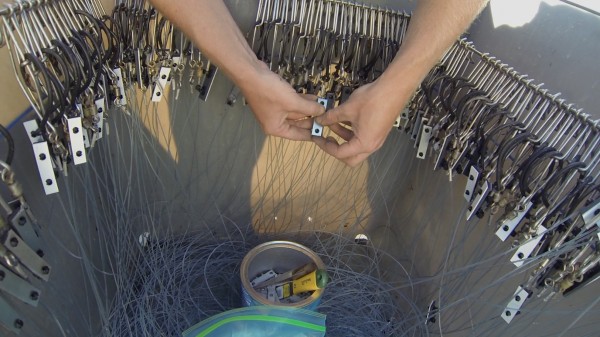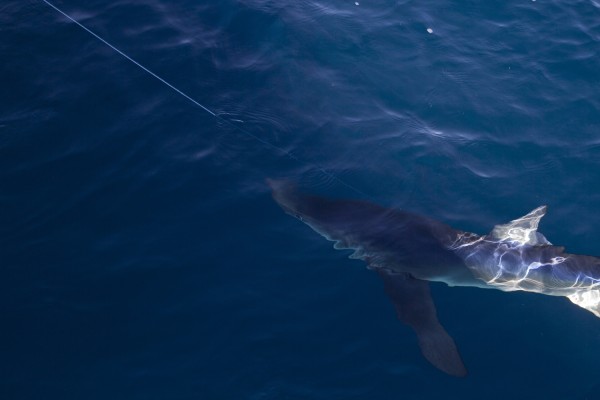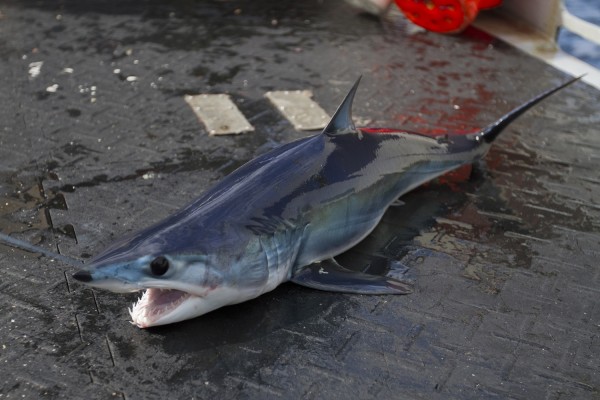Through the looking glass: A conservation perspective from a commercial fishermen’s point of view
Written by Jarrett Corke, Project Coordinator, Sharks
I needed time. Time to think. Time to process fleeting memories and photographs and make sense of it all. I know what I expected to find, but the reality was something different, something more profound and complicated than I had anticipated.
You may remember a blog that my colleague Tonya Wimmer wrote a few weeks back – “Testing the waters: experimenting new tools in shark conservation” . This is the follow up to that blog. It’s been nearly four weeks since I returned from the two-week expedition at sea. A quick reminder of why we were out there – we partnered with U.S. researcher, Kieran Smith, from the Florida Atlantic University and Canadian pelagic longline fishermen to test the use of potential shark mitigation gear in the swordfish fishery. To be specific, we’ve added small pieces of zinc and graphite above the fishing hooks. Once submerged in salt water, these metals react to create an electric field that sharks, unlike other fish – like swordfish, can detect. Our hope – that this electric field will deter sharks.
Now that I’m back, the question that comes to mind: “Well… did it work?”. Unfortunately, we don’t have a definitive answer to that question… yet. We’re still crunching the numbers. Instead I’ll speak to what I do know – what I saw.
For those of you that have not spent much time on boats, let me be the first to tell you that two weeks at sea in the North Atlantic is a long time. Being my first trip out on a fishing boat for more than a day or two, it felt more like two months. Your sense of time and place quickly evaporates and all that you’re left with is a distinct sense of purpose in completing your task and going home. For myself that meant testing the gear and recording the catch; for the fishermen that meant catching swordfish.
The days in pursuit of swordfish were long. So too was the gear the fishermen were setting. We’re talking about more than 700 hooks stretched out over 25 miles of line set not in a straight line, but following a particular temperature where swordfish are likely to be found. However, in addition to catching swordfish several other species were caught on the gear including tunas, turtles and sharks. While some of the tunas were kept, the turtles and sharks were released. This is what’s known as bycatch. The most commonly encountered bycatch species in this fishery is the blue shark.
© Jarrett Corke
This fishery catches a large volume of sharks, particularly blue sharks. Fishermen do not dispute this. However, despite what you may have heard, fishermen don’t like catching sharks and with good reasons too. To catch a shark means there is one less hook to catch what they’re out there for – swordfish. It also amounts to lost gear (e.g. hook and line) and time. Don’t forget to factor in the danger of catching these animals. Irritated makos and parting gear flying back onboard are only a few concerns.
© Jarrett Corke
Knowing all of this, there is an innate interest to work together on reducing catch of sharks in this fishery. While we cannot say yet whether the experiment itself was a success or not, I can say that coordinating a project such as this is an instant success. At the risk of gloating this is something not every organization is able to accomplish, especially when it comes to working on a complicated issue like bycatch.
What I saw out there wasn’t perfect, but nothing is. Fishing inevitably leads to bycatch. That’s the truth. There are few, if any, fisheries out there that can escape this reality. This is a something that fishermen live and breathe and, unfortunately, few people know and/or understand. A simple truth that we are working together to change to ensure our fisheries are sustainable and impacts on the ocean is minimal.
As I see it, my job is two-fold: first, to work with fishermen to better understand the what is happening on the water and, wherever possible, work with them to improve the situation for sharks. Second, I need to inform the public about this situation and help them realize what is happening to the oceans and the sharks that live in it.
So, did the experiment work? We’ll let you know.




